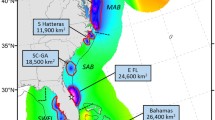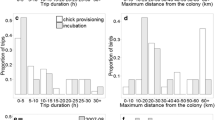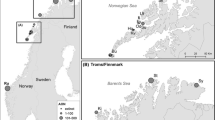Abstract
Migratory animals spend different periods of their lives in widely separated and ecologically different locations; their experiences from one activity/period/site (e.g., foraging) can dramatically affect their success during another (e.g., breeding). Carry-over effects reflect the influence of foraging quality on reproductive behaviors of migratory species, such as nesting loggerhead sea turtle (Caretta caretta), which vary greatly in body size and reproductive parameters. We investigated carry-over effects on 330 loggerheads nesting at the Archie Carr National Wildlife Refuge (Melbourne Beach, Florida), one of the largest aggregations in the Western Hemisphere, using telemetry, stable isotope analysis and reproductive parameters. We assigned foraging locations used during the non-breeding period with discriminant function analysis and determined the relative contributions to different foraging regions from 2007 to 2012. Foraging regions significantly influenced female body size and fecundity. Loggerheads foraging southeast of the nesting beach in the vicinity of the Bahamas and Florida Keys laid larger clutches and had a shorter breeding frequency. On average, 47 % (±3 % SE) of the females foraged year-round in this area, while 33 % (±4 % SE) resided on the Southwest Florida continental shelf south of Tampa Bay and 18 % (±2 % SE) undertook seasonal migrations and foraged north of Cape Hatteras, North Carolina. Relative contributions to the foraging areas did not change over the 6-year period. The northern foraging area consistently contributed the fewest females despite being the most productive oceanographic region suggesting a trade-off between foraging area productivity and distance to the nesting beach. We reaffirm that the isotopic approach can be used to interpret trends in abundance at nesting beaches and demographic parameters affecting those trends. Understanding geospatial linkages and relative importance of foraging areas is critical to fostering appropriate management and conservation strategies for migratory species.





Similar content being viewed by others
References
Arendt MD, Boynton J, Schwenter JA, Segars AL, Byrd JI et al (2012a) Spatial clustering of loggerhead sea turtles in the Northwest Atlantic: implications for management surveys. Endang Species Res 18:219–231. doi:10.3354/esr00450
Arendt MD, Schwenter JA, Boynton J, Segars AL, Byrd JI et al (2012b) Temporal trends (2000–2011) and influences on fishery-independent catch rates for loggerhead sea turtles (Caretta caretta) at an important coastal foraging region of the Southeast U.S. Fish Bull 110:470–483
Arendt MD, Schwenter JA, Witherington BE, Meylan AB, Saba VS (2013) Historical versus contemporary climate forcing on the annual nesting variability of loggerhead sea turtles in the Northwest Atlantic Ocean. PLoS ONE 8:e81097. doi:10.1371/journal.pone.0081097
Barrow LM, Bjorndal KA, Reich KJ (2008) Effects of preservation method on stable carbon and nitrogen isotope values. Physiol Biochem Zool 81:688–693. doi:10.1086/588172
Bjorndal KA, Carr A (1989) Variation in clutch size and egg size in the green turtle nesting population at Tortuguero, Costa Rica. Herpetologica 45:181–189. doi:10.2307/3892160
Bjorndal KA, Meylan AB, Turner BJ (1983) Sea turtles nesting at Melbourne Beach, Florida, I. Size, growth and reproductive biology. Biol Conserv 26:65–77. doi:10.1016/0006-3207(83)90049-6
Bowen BW, Bass AL, Chow SM, Bostrom M, Bjorndal KA, Bolten AB, Okuyama T, Bolker BM, Epperly S, Lacasella E (2004) Natal homing in juvenile loggerhead turtles (Caretta caretta). Mol Ecol 13:3797–3808. doi:10.1111/j.1365-294X.2004.02356.x
Bowen GJ, Wassenaar LI, Hobson KA (2005) Global application of stable hydrogen and oxygen isotopes to wildlife forensics. Oecologia 143:337–348. doi:10.1007/s00442-004-1813-y
Broderick AC, Coyne MS, Fuller WJ, Glen F, Godley BJ (2007) Fidelity and over-wintering of sea turtles. Proc R Soc B 274:1533–1538. doi:10.1098/rspb.2007.0211
Brost B, Witherington B, Meylan A, Leone E, Ehrhart L, Bagley D (2015) Sea turtle hatchling production from Florida (USA) beaches, 2002–2012, with recommendations for analyzing hatching success. Endanger Species Res 27:53–68. doi:10.3354/esr00653
Ceriani SA, Roth JD, Evans DR, Weishampel JF, Ehrhart LM (2012) Inferring foraging areas of nesting loggerhead turtles using satellite telemetry and stable isotopes. PLoS ONE 7:e45335. doi:10.1371/journal.pone.0045335
Ceriani SA, Roth JD, Ehrhart LM, Quintana-Ascencio PF, Weishampel JF (2014a) Developing a common currency for stable isotope analyses of nesting marine turtles. Mar Biol 161:2257–2268. doi:10.1007/s00227-014-2503-x
Ceriani SA, Roth JD, Sasso CR, McClellan CM, James MC, Haas HL, Smolowitz RJ, Evans DR, Addison DS, Bagley DA (2014b) Modeling and mapping isotopic patterns in the Northwest Atlantic derived from loggerhead sea turtles. Ecosphere. doi:10.1890/ES14-00230.1
Dodd C, Byles R (2003) Post-nesting movements and behavior of loggerhead sea turtles (Caretta caretta) departing from east-central Florida nesting beaches. Chelonian Conserv Biol 4:530–536
Eder E, Ceballos A, Martins S, Pérez-García H, Marn I, Marco A, Cardona L (2012) Foraging dichotomy in loggerhead sea turtles Caretta caretta off northwestern Africa. Mar Ecol Prog Ser 470:113–122. doi:10.3354/meps10018
Ehrhart L, Bagley D, Redfoot W (2003) Loggerhead turtles in the Atlantic Ocean: geographic distribution, abundance, and population status. In: Bolten AB, Witherington BE (eds) Loggerhead sea turtles. Smithsonian Institution Press, Washington, pp 157–174
Ehrhart L, Redfoot W, Bagley D, Mansfield K (2014) Nesting and reproductive success at an important western Atlantic Rookery. Chelonian Cons Biol 2:173–181
Foley AM, Schroeder BA, Hardy R, MacPherson SL, Nicholas M, Coyne MS (2013) Postnesting migratory behavior of loggerhead sea turtles Caretta caretta from three Florida rookeries. Endang Species Res 21:129–142. doi:10.3354/esr00512
González-Solís J, Smyrli M, Militão T, Gremillet D, Tveraa T, Phillips RA, Boulinier T (2011) Combining stable isotope analyses and geolocation to reveal kittiwake migration. Mar Ecol Prog Ser 435:251–261. doi:10.3354/meps09233
Graham BS, Koch PL, Newsome SD, McMahon KW, Aurioles D (2010) Using isoscapes to trace the movements and foraging behavior of top predators in oceanic ecosystems. In: West JB, Bowen GB, Dawson TE, Tu KP (eds) Isoscapes: understanding movement, pattern and process on earth through isotope mapping. Springer, New York, pp 299–318
Griffin DB, Murphy SR, Frick MG, Broderick AC, Coker JW, Coyne MS, Dodd MG, Godfrey MH, Godley BJ, Hawkes LA, Murphy TM, Williams KL, Witt MJ (2013) Foraging habitats and migration corridors utilized by a recovering subpopulation of adult female loggerhead sea turtles: implications for conservation. Mar Biol 160:3071–3086. doi:10.1007/s00227-013-2296-3
Harrison XA, Blount JD, Inger R, Norris DR, Bearhop S (2011) Carry-over effects as drivers of fitness differences in animals. J Anim Ecol 80:4–18. doi:10.1111/j.1365-2656.2010.01740.x
Hatase H, Takai N, Matsuzawa Y, Sakamoto W, Omuta K, Goto K, Arai N, Fujiwara T (2002) Size-related differences in feeding habitat use of adult female loggerhead turtles Caretta caretta around Japan determined by stable isotope analyses and satellite telemetry. Mar Ecol Prog Ser 233:273–281. doi:10.3354/meps233273
Hatase H, Omuta K, Tsukamoto K (2013) A mechanism that maintains alternative life histories in a loggerhead sea turtle population. Ecology 94:2583–2594. doi:10.1890/12-1588.1
Hatase H, Omuta K, Komatsu T (2014) Do loggerhead turtle (Caretta caretta) eggs vary with alternative foraging tactics? J Exp Mar Biol Ecol 455:56–61. doi:10.1016/j.jembe.2014.03.002
Hawkes LA, Broderick AC, Coyne MS, Godfrey MH, Lopez-Jurado LF, Lopez-Suarez P, Merino SE, Varo-Cruz N, Godley BJ (2006) Phenotypically linked dichotomy in sea turtle foraging requires multiple conservation approaches. Curr Biol 16:990–995. doi:10.1016/j.cub.2006.03.063
Hawkes LA, Witt MJ, Broderick AC, Coker JW, Coyne MS, Dodd M, Frick MG, Godfrey MH, Griffin DB, Murphy SR, Murphy TM, Williams KL, Godley BJ (2011) Home on the range: spatial ecology of loggerhead turtles in Atlantic waters of the USA. Divers Distrib 17:624–640. doi:10.1111/j.1472-4642.2011.00768.x
Hobson KA, Norris RD (2008) Animal migration: a context for using new techniques and approaches. In: Hobson KA, Wassenaar LI (eds) Tracking animal migration with stable isotopes. Academic Press Terrestrial Ecology Series, London, pp 1–19
IUCN (2013) IUCN red list of threatened species. Version 2013.2. www.iucnredlist.org. Accessed 16 Jan 2014
Jaeger A, Lecomte VJ, Weimerskirch H, Richard P, Cherel Y (2010) Seabird satellite tracking validates the use of latitudinal isoscapes to depict predators’ foraging areas in the Southern Ocean. Rapid Commun Mass Spectrom 24:3456–3460. doi:10.1002/rcm.4792
McMahon KW, Ling Hamady L, Thorrold SR (2013) A review of ecogeochemistry approaches to estimating movements of marine animals. Limnol Oceanogr 58:697–714. doi:10.4319/lo.2013.58.2.0697
Meylan AB, Bjorndal KA, Turner BJ (1983) Sea turtles nesting at Melbourne beach, Florida, II. Post-nesting movements of Caretta caretta. Biol Conserv 26:79–90
Miller JD (1997) Reproduction in sea turtles. In: Lutz PL, Musick JA (eds) The biology of sea turtles I. CRC Press, Boca Raton, pp 51–80
Miller JD (1999) Determining clutch size and hatching success. In: Eckert KL, Bjorndal KA, Abreu-Grobois FA, Donnelly M (eds) Research and management techniques for the conservation of sea turtles. Publication no. 4. IUCN/SSC Marine Turtle Specialist Group, Blanchard, pp 124–129
Miller JD, Limpus CJ, Godfrey MH (2003) Nest site selection, oviposition, eggs, development, hatching, and emergence of loggerhead turtles. In: Bolten AB, Witherington BE (eds) Loggerhead sea turtles. Smithsonian Institution Press, Washington, pp 125–143
Moncada F, Abreu-Grobois FA, Bagley D, Bjorndal KA, Bolten AB, Camiñas JA, Ehrhart L, Muhlia-Melo A, Nodarse G, Schroeder BA, Zurita J, Hawkes LA (2010) Movement patterns of loggerhead turtles Caretta caretta in Cuban waters inferred from flipper tag recaptures. Endang Species Res 11:61–68. doi:10.3354/esr00248
National Marine Fisheries Service and US Fish and Wildlife Service (2008) Recovery plan for the Northwest Atlantic population of the loggerhead sea turtle (Caretta caretta). Second revision. National Marine Fisheries Service, Silver Spring. www.nmfs.gov/pr/recovery/plans.htm#turtles. Accessed 20 March 2012
Pajuelo M, Bjorndal KA, Reich KJ, Arendt MA, Bolten AB (2012a) Distribution of foraging habitats of male loggerhead turtles (Caretta caretta) as revealed by stable isotopes and satellite telemetry. Mar Biol 159:1255–1267. doi:10.1007/s00227-012-1906-9
Pajuelo M, Bjorndal KA, Reich KJ, Vander Zanden HB, Hawkes LA, Bolten AB (2012b) Assignment of nesting loggerhead turtles to their foraging areas in the Northwest Atlantic using stable isotopes. Ecosphere. doi:10.1890/ES12-00220.1
Pike DA, Stiner JC (2007) Sea turtle species vary in their susceptibility to tropical cyclones. Oecologia 153:471–478. doi:10.1007/s00442-007-0732-0
R Development Core Team (2011) R: a language and environment for statistical computing. R Foundation for Statistical Computing, Vienna
Radabaugh KR, Hollander DJ, Peebles EB (2013) Seasonal δ13C and δ15N isoscapes of fish populations along a continental shelf trophic gradient. Cont Shelf Res 68:112–122. doi:10.1016/j.csr.2013.08.010
Reece JS, Passeri D, Ehrhart L, Hagen SC, Hays A, Long C, Noss RF, Bilskie M, Sanchez C, Schwoerer MV, Von Holle B, Weishampel J, Wolf S (2013) Sea-level rise, land use, and climate change influence the distribution of loggerhead turtle nests at the largest USA rookery (Melbourne Beach, Florida). Mar Ecol Prog Ser 493:259–274. doi:10.3354/meps10531
Reich KJ, Bjorndal KA, Martinez Del Rio C (2008) Effects of growth and tissue type on the kinetics of 13C and 15N incorporation in a rapidly growing ectotherm. Oecologia 155:651–663. doi:10.1007/s00442-007-0949-y
Reich KJ, Bjorndal KA, Frick MG, Witherington BE, Johnson C, Bolten AB (2010) Polymodal foraging in adult female loggerheads (Caretta caretta). Mar Biol 157:113–121. doi:10.1007/s00227-009-1300-4
Saba VS, Santidrían-Tomillo P, Reina RD, Spotila JR, Musick JA, Evans DA, Paladino FV (2007) The effect of the El Niño Southern Oscillation on the reproductive frequency of eastern Pacific leatherback turtles. J Appl Ecol 44:395–404. doi:10.1111/j.1365-2664.2007.01276.x
Seminoff JA, Bjorndal KA, Bolten AB (2007) Stable carbon and nitrogen isotope discrimination and turnover in pond sliders Trachemys scripta: insights for trophic study of freshwater turtles. Copeia 2007:534–542. doi:10.2307/25140663
Seminoff JA, Benson SR, Arthur KE, Eguchi T, Dutton PH, Tapilatu RF, Popp BN (2012) Stable isotope tracking of endangered sea turtles: validation with satellite telemetry and δ15N analysis of amino acids. PLoS ONE 7:e37403. doi:10.1371/journal.pone.0037403
Seney EE, Musick JA (2007) Historical diet analysis of loggerhead sea turtles (Caretta caretta) in Virginia. Copeia 2007:478–489
Shamblin BM, Dodd MG, Bagley DA, Ehrhart LM, Tucker AD, Johnson C, Carthy RR, Scarpino RA, McMichael E, Addison DS, Williams KL, Frick MG, Ouellette S, Meylan AB, Godfrey MH, Murphy SR, Nairn CJ (2011) Genetic structure of the southeastern United States loggerhead turtle nesting aggregation: evidence of additional structure within the peninsular Florida recovery unit. Mar Biol 158:571–587. doi:10.1007/s00227-010-1582-6
Shamblin BM, Bolten AB, Bjorndal KA, Dutton PH, Nielsen JT, Abreu-Grobois FA, Reich KJ, Witherington BE, Bagley DA, Ehrhart LM (2012) Expanded mitochondrial control region sequences increase resolution of stock structure among North Atlantic loggerhead turtle rookeries. Mar Ecol Prog Ser 469:145–160. doi:10.3354/meps09980
Shine R (1992) Relative clutch mass and body shape in lizards and snakes: is reproductive investment constrained or optimized? Evolution 46:828–833. doi:10.2307/2409650
Sokal RR, Rohlf FJ (1994) Biometry. WH Freeman, San Francisco
Stearns SC (1992) The evolution of life histories. Oxford University Press, London, p 249
Tucker AD, MacDonald BD, Seminoff JA (2014) Foraging site fidelity and stable isotope values of loggerhead turtles tracked in the Gulf of Mexico and northwest Caribbean. Mar Ecol Prog Ser 502:267–279. doi:10.3354/meps10655
Vander Zanden HB, Bjorndal KA, Reich KJ, Bolten AB (2010) Individual specialists in a generalist population: results from a long-term stable isotope series. Biol Lett 6:711–714. doi:10.1098/rsbl.2010.0124
Vander Zanden HB, Pfaller JB, Reich KJ, Pajuelo M, Bolten AB, Williams KL, Frick MG, Shamblin BM, Nairn CJ, Bjorndal KA (2014) Foraging areas differentially affect reproductive output and interpretation of trends in abundance of loggerhead turtles. Mar Biol 161:585–598. doi:10.1007/s00227-013-2361-y
Vander Zanden HB, Tucker AD, Hart KM, Lamont MM, Fujisaki I, Addison DS, Mansfield KL, Phillips KF, Wunder MB, Bowen GJ, Pajuelo M, Bolten AB, Bjorndal KA (2015) Determining origin in a migratory marine vertebrate: a novel method to integrate stable isotopes and satellite tracking. Ecol Appl 25:320–335. doi:10.1890/14-0581.1
Wallace BP, Sotherland PR, Tomillo PS, Reina RD, Spotila JR, Paladino FV (2007) Maternal investment in reproduction and its consequences in leatherback turtles. Oecologia 152:37–47. doi:10.1007/s00442-006-0641-7
Webster MS, Marra PP, Haig SM, Bensch S, Holmes RT (2002) Links between worlds: unraveling migratory connectivity. Trends Ecol Evol 17:76–83. doi:10.1016/S0169-5347(01)02380-1
Wibbels T (2003) Critical approaches to sex determination in sea turtles. In: Lutz PL, Musick JA, Wyneken J (eds) The biology of sea turtles II. CRC Press, Boca Raton, pp 103–134
Wilkinson TA, Wiken E, Creel JB, Hourigan TF, Agardy T, Herrmann H, Janishevski L, Madden C, Morgan LE, Padilla M (2009) Marine ecoregions of North America. Commission for Environmental Cooperation, Montreal
Williams KL, Frick MG (2008) Tag returns from loggerhead turtles from Wassaw Island, GA. Southeast Nat 7:165–172. doi:10.1656/1528-7092(2008)7[165:TRFLTF]2.0.CO;2
Witherington B, Kubilis P, Brost B, Meylan A (2009) Decreasing annual nest counts in a globally important loggerhead sea turtle population. Ecol Appl 19:30–54. doi:10.1890/08-0434.1
Wunder MB (2012) Determining geographic patterns of migration and dispersal using stable isotopes in keratins. J Mammal 93:360–367. doi:10.1644/11-MAMM-S-182.1
Zbinden JA, Bearhop S, Bradshaw P, Gill B, Margaritoulis D, Newton J, Godley BJ (2011) Migratory dichotomy and associated phenotypic variation in marine turtles revealed by satellite tracking and stable isotope analysis. Mar Ecol Prog Ser 421:291–302. doi:10.3354/meps08871
Acknowledgments
We thank B. Sharma, R. Woods, A. Hays, A. Sterner, C. Sanchez, C. Long, F. Gusmao, R. Chabot, C. Amato, K. Cope, T. Williamson, D. Bagley and forty undergraduate students for their help with sample collection at the ACNWR and assistance with laboratory work. We thank A. Savage, the staff and volunteers of the Sea Turtle Conservancy, the Brevard County Barrier Island Center, the Disney’s Vero Beach Resort, the Conservancy of Southwest Florida staff, the Mote Marine Laboratory staff, C. Johnson and K. Martin for assistance with satellite deployment and sampling on nesting beaches. We thank G. Worthy and the PEBL laboratory for providing laboratory access and advice, P.F. Quintana-Ascencio, L. Walters, E. Valdes, J. Fauth, A. Foley, A. Chester, J. Bohnsack, B. Wallace and two anonymous reviewers for advice and suggestions that significantly improved this manuscript. We thank the Archie Carr National Wildlife Refuge Managers and in particular K. Kneifl for supporting our research. SAC thanks B. Shamblin for sharing samples, E. Goddard for assistance with stable isotope analysis, the Florida Fish and Wildlife Research Institute for allowing the work to be completed at the Institute and B. Brost. The animal use protocol for this research was reviewed and approved by the University of Central Florida Institutional Animal Care and Use Committee (IACUC protocols #09-22W and #12-22W). Procedures were approved under the Florida Fish and Wildlife Conservation Commission (Marine Turtle Permit #025). This work was supported by several grants awarded from the Sea Turtle Grants Program (09-055R, 10-020R, 10-023R, 11-021R). The Sea Turtle Grants Program is funded from proceeds from the sale of the Florida Sea Turtle License Plate. Learn more at www.helpingseaturtles.org.
Author information
Authors and Affiliations
Corresponding author
Additional information
Communicated by B. Wallace.
Reviewed by undisclosed experts.
Rights and permissions
About this article
Cite this article
Ceriani, S.A., Roth, J.D., Tucker, A.D. et al. Carry-over effects and foraging ground dynamics of a major loggerhead breeding aggregation. Mar Biol 162, 1955–1968 (2015). https://doi.org/10.1007/s00227-015-2721-x
Received:
Accepted:
Published:
Issue Date:
DOI: https://doi.org/10.1007/s00227-015-2721-x




